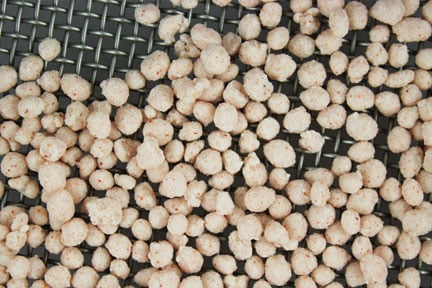More than 30 million tonnes of potash are produced worldwide each year, making it an important mineral for a number of product manufacturers, as well as an integral component in fruitful crop production. However, potash’s widespread use does not mean it is always easy to process; demanding material characteristics combined with unique processing requirements necessitate an experienced hand to achieve desired results.
There are two primary methods by which potash can be processed: tumble-growth agglomeration on a disc pelletizer, or through compaction granulation in a compactor, the choice between which is dictated by desired end product characteristics, process requirements, and cost. Each of these methods, combined with the characteristics of potash, presents its own unique challenges. The following list highlights some of the most common challenges experienced during potash processing when utilizing these two approaches.
The Pelletization Method
Moisture Levels
Throughout the pelletization process, achieving and maintaining ideal moisture levels is a critical consideration, affecting nearly all parts of the process, as well as the outcome. Moisture levels must be carefully monitored during conditioning, pelletizing, and drying.
Conditioning potash in a pin mixer prior to the disc pelletizer is a common practice in the pelletization method of processing potash. Here, two things are accomplished: raw material fines are vigorously mixed with a binder to create a homogeneous mixture, and raw material is brought up to the appropriate moisture level for optimum pellet formation. Too little or too much moisture in this stage will cause the material to be ill prepared for pellet formation on the disc pelletizer.
Once the potash is fed onto the pan pelletizer, pellet formation begins. Here, additional binder is added to increase tackiness and foster desired pellet growth. In this stage too, moisture is of crucial concern. Too little or too much will not allow for desired pellet size or characteristics.
After the potash has been pelletized, the “green” pellets must be brought down to the moisture level required for the end product. It is here that an industrial drying system must be employed. A dryer such as a rotary dryer, specifically designed around material and process requirements, will achieve the best results. In addition, a co-current air-flow will ensure product integrity is maintained. If a counter-current air-flow were to be utilized, product damage would likely occur in the form of discoloration and attrition issues, because the hottest gases would be coming into contact with the driest product.
The Compaction Granulation Method
Attrition
The process of compaction granulation creates compacted potash granules with rough surfaces and jagged edges. Consequently, rough surfaces and jagged edges wear against each other, in a process referred to as attrition. Not only does the size and shape of the compacted potash granules change through attrition, but a large amount of unwanted potash fines are also produced, resulting in a dusty product, and material waste. This occurrence is minimized through the addition of a polishing drum. In a polishing drum, granules are tumbled, causing loose edges to break off, rounding out and polishing the product. The resulting fines are subsequently removed during screening and used as recycle in the compaction circuit.
As an alternative to a polishing drum, a paddle mixer may be added after compaction. In this configuration, compacted granules go from the compactor to the paddle mixer, where they are wetted and then dried in a rotary dryer. This act of wetting and drying the granules helps to eliminate sharp edges, as well as fill in surface cracks on the granules that would otherwise contribute to attrition.
General Potash Processing Challenges
Clumping
Potash, due to its hygroscopic quality, is often prone to clumping, sticking, and caking issues. These issues may show up during drying, or storage. However, there are steps that can be taken to combat this.
- Drying: Knocking systems can be added to rotary dryers as a method to break up lumps amongst the material itself, as well as dislodge any material that may be sticking to the interior of the drum.
- Screw Conveyors: Another equipment-based solution to prevent clumps is the addition of a screw conveyor. The screw conveyor utilizes a feed trajectory that ‘flings’ potash into the dryer. This motion efficiently conveys the material and breaks up lumps in the process.
- Anti-Caking Additives: Anti-caking additives are applied to finished granules through the use of a paddle mixer. A variety of anti-caking additives are available, depending upon material characteristics and end product use.
Corrosion
Another potash processing challenge that manufactures experience is corrosion. Since potash is a corrosive material, it can progressively destroy metal through chemical action. For certain equipment, special accommodations must be made in order to counteract potash’s corrosive nature. One example of this customization is the use of stainless steel or nickel alloys on areas of the equipment that come into contact with potash during processing.
Processing potash may be a widespread practice, but that doesn’t mean it is not without its challenges. FEECO is adept in both the compaction granulation and pelletization methods of processing potash. Ever familiar with the challenges that potash can present, we also offer feasibility testing for potash product and process development. At FEECO, we have over 75 years of experience solving potash processing issues. For more information on our potash processing equipment and solutions, contact us today!

